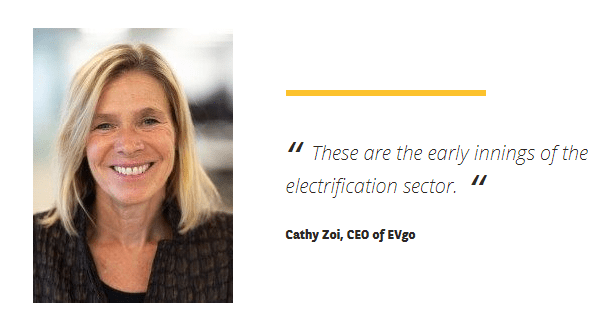As the US economy shifts back towards sustainability, it will need to accelerate its switch to renewable energy, electric mobility and circular economy.
The US economy is quickly pivoting to a greater focus on the climate following its re-joining of the Paris Climate Accord and President Biden’s participation at COP26 in Glasgow. While the US can still reach net-zero by 2050, the country must accelerate its efforts by advancing new technologies to decarbonise power and mobility, mobilizing the public and private sectors – including the investor community – and shifting its economy to a circular model.
Experts and industry leaders from across the United States, and beyond, gathered at BNP Paribas’ Sustainable Future Forum – Global Edition to share their perspectives.
The US journey to decarbonisation
The world is not only at its warmest level in 10,000 years, but the temperature rise is accelerating, warned Professor Jeffrey Sachs, Economist and Director of the Centre for Sustainable Development at Columbia University in his SFF speech. The world’s energy system must decarbonise to fight the current climate urgency, he added, highlighting findings from the International Energy Agency’s Net Zero by 2050 paper.
The paper shows that achieving net-zero is possible using existing or evolving technologies, such as renewable power, electrification, hydrogen and green fuels.
The US has set out a pathway to reach net-zero by 2050 primarily by solar and wind, Sachs said, citing the US Department of Energy’s Solar Futures Study. In addition, the cost of getting to net-zero in the US is a small fraction of national income, he stated, which should provide extra momentum to government and business to deploy the financing and technologies needed to reach the goal.
A shift to renewables and hydrogen
Conscious of the shift in investor and stakeholder sentiment on climate change, leading US companies in the energy space are moving to a low-carbon future while acknowledging the need for a diversified portfolio – for example, increasing solar power and nuclear energy footprints while reducing coal.
While investors and the market overall are driving a pivot toward climate infrastructure, Steve Porto, Managing Director at Ares Management, underlined that renewable energy initiatives across the US will take time to implement.
“We are years – if not decades – away from being able to power the grid with wind, solar and batteries when it is neither windy nor sunny,” said Porto. Natural gas would likely continue to serve as a bridge fuel to a much lower carbon future, he added.
New technologies will play a key role in that future, in particular green hydrogen. Phillippe Delleville, Global Head of Project & Development Finance Solutions at Siemens Gamesa, explained that the firm is looking at designing wind farms with the purpose of generating hydrogen (and electricity) onshore as well as developing wind turbines entirely dedicated to hydrogen offshore. Porto’s Ares Management is partnering with the Port of Corpus Christi, Texas, to explore opportunities to deliver hydrogen using existing infrastructure and renewables assets.
Electrifying the future
With transportation accounting for about 29 percent of total US greenhouse gas emissions, electric vehicles (EVs) will be a key lever in the country’s race to net-zero. US carmakers have dramatically increased their EV investments, to US$65 billion in 2027, according to BloombergNEF. Ford and General Motors each announced ambitious electrification plans while also signing the Glasgow Accord on Zero Emissions Vehicles, which calls for automakers to only sell zero-emissions vehicles by 2040.
But that investment alone won’t be enough to lure American drivers from the combustion engine. In order to get more EVs on the road, the US needs to significantly increase its electric infrastructure and meet the growing demand for fast-charging stations. Whereas consumers may be reluctant to purchase EVs due to range anxiety, fast-charging infrastructure can now provide 150 miles of driving range in under 15 minutes, said Cathy Zoi, CEO at EVgo. She further noted that policy can play a role in “accelerating the imperative” and bringing charging infrastructure to more places across the US.

Electrification does have challenges as a nascent sector. Batteries are susceptible to heightened fire risk while others cite environmental concerns in mining the metals used in EV batteries such as cobalt and lithium. But Zoi noted that the technology will continue to improve over time.
“These are the early innings of the electrification sector,” Zoi said, adding that issues surrounding battery safety are being closely examined and that precious metal mining operations are becoming more sustainable.
Voice of investors driving change
The US$1 trillion infrastructure bill passed by Congress – which will include funding for climate change and clean energy programmes – will be a driver of huge change in the US, and send a signal globally that the country is committed to a net-zero pathway.
Investors and companies have an important voice in these discussions, and need to weigh in at a public policy level, according to Mindy Lubber, CEO and President of sustainability non-profit Ceres. She remarked that institutional investors are becoming increasingly vocal about climate change, and are pushing companies to green their businesses. She cited the Climate Action 100+ initiative – which consists of more than 590 institutions managing over $47 trillion – as an example of how investors are pushing governments to strengthen national commitments to climate investment.
Private Equity will also play a major role in the US sustainability transition, both through a greater focus on investing in firms that take ESG seriously, and by partnering with portfolio companies to understand the climate change topic and set a trajectory to transition, said Elizabeth Seeger, Managing Director, Sustainable Investing at KKR.
Risk disclosures will be key in helping to drive change. For example, KKR is using the Task Force on Climate-Related Financial Disclosures (TCFD) template as a framework when asking companies to report on their climate risks.
Going circular
The shift of the US to a future powered by renewables dovetails with the circular economy, where resources are designed to be sustainably recycled across the value chain. Peter Perrault, Senior Manager, Circular Economy & Sustainable Solutions at Enel North America, explained how his firm is integrating sustainable land use to its renewable power projects, including dual-use approaches that will plant native vegetation around solar installations, for example.
Wind power provides another example. As wind turbine blades age, Perrault said the firm is looking at repurposing the material for structural and civil use – converting blades into transmission and distribution poles for new electrical lines, sea walls and pedestrian bridges along greenway spaces.
Moving in the right direction
With investors and stakeholders pushing the case for strong sustainability action at COP26, many US corporates are already taking substantive steps to become greener through decarbonisation, electrification and by embracing the circular economy.

